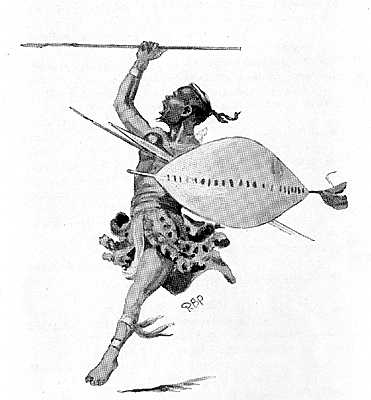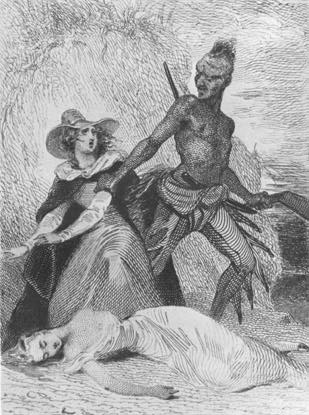Edgar Rice Burroughs created a hero and a phenomenon that is still going strong almost a century later
By Lois Legge
"The tribe that Tarzan first meets are described as cannibals, as are pretty much every black African that’s represented," he says. "There’s an African-American figure in the character of Jane’s nanny who fulfills all the stereotypes of the southern mammy figure. She’s sycophantic, she’s childlike, she’s superstitious, she . . . simply becomes a comic figure through her speech, through her malapropisms. . . . If you’ve ever seen Gone with the Wind, she is that figure, it’s the same character almost to a T.
"So the novel runs the gamut of anti-black racist stereotypes. Against this . . . Tarzan ends up being compared to the racistly-depicted savagery of the blacks and . . . Tarzan becomes this figure who can negotiate with vigour the physical demands of the jungle but also behaves rationally like the proper ‘civilized white man.’ "
Burroughs’ 25 sequels continue the stereotypes in one way or another, Haslam says, noting the character of Tarzan is by turns violently, or paternalistically, racist.
And some of the racial stereotypes the books depict have lived on in the larger culture.
"It didn’t create these stereotypes but it certainly helped to perpetuate them," says the professor, sitting in his Dalhousie office, two copies of Tarzan of the Apes at hand.
"I remember a certain Toronto mayor, it was Mel Lastman—it was during a Toronto Olympic bid when he was going to Africa—said that he had visions of being boiled in a pot. You know these are the stereotypes, whether he’s getting it from Tarzan or Bugs Bunny cartoons or whatever."
I think most of us could list the usual African stereotypes. We've probably seen about as many old jungle movies as old Westerns.
But the African stereotypes have mostly faded from the scene. You may see them a few times a year, but that's about it. When a teabagger portrayed Obama as a witch doctor, it was shocking because it was so rare. Almost everyone condemned the picture because it was so obviously racist.
And yet...for every African cannibal boiling a white man in a pot, we must see hundreds of Native stereotypes. These stereotypes are almost everywhere: at the checkout stand, in children's toys, on global TV, etc. They're just as outdated and offensive, but they're infinitely more pervasive. You'd have a hard time not seeing them every day.
Our society condemns depictions of blacks as 19th-century savages, yet cherishes depictions of Indians as 19th-century savages. And we're still trying to address that, to figure out why that's so. Why is one type of racist stereotype considered odious while the other is perfectly acceptable to most Americans?
For more on the subject, see Rima the "Native" White Girl and Indians Look Like Tarzan?
Below: Which outdated stereotype is still common in America?



5 comments:
If you have seen the 1933 FULL unedited version of the original KING KONG film, there are scenes where Kong eats, rampages the village and repeatedly steps on an African native and even fondles Fay Wray, something I don't quite remember seeing over the years during my young "Kong" years.
For some reason, the edited versions we all have grown to know and love show no such scenes, but I caught this version last night on TMC (Turner Movie Classics).
The worst Kong film, in my opinion was the 1976 version with Jeff Bridges and Kong arousing Jessica Lange near a waterfall, obviously a fake, craned robot. Again, we have the naked African natives dancing about in feathers, bones and sexual savagery throwing in a little greed for fossil fuels.
The irony is that the recent 2005 newer version of KING KONG with Adrien Brody and Jack Black fares no better. The natives are cannibalistic, evil and dirty.
America would not be America without racism.
The reason I bring these three films to light is that there was a WWII ARMY Enlistment poster with anti-German sentiments showing King Kong wearing a Nazi helmet and abducting the statue of Liberty. The words, "Destroy This Mad Brute" cover the top in bold letters while the word ENLIST blankets US ARMY!
How is this not Government sponsored racism?
Burroughs is no different than other literary giants that helped create and maintain stereotypical tokens for minorities.
Writers like Mark Twain AKA Samuel Clemens and L Frank Baum blatantly utilized racial slurs in novels and political leanings, how are we to expect generations of non-native writers, film directors and producers to be even the slightest in accuracy, depicting intelligence in dealing with indigenous cultures?
Until minorities take the reigns at writing, directing and producing film and books, or the academias, schools and universities evolve into ACTUAL institutions of learning and factual intelligence, as opposed to social engineering for the religious right and the defense industry, I am afraid the myth of the American story will remain, as it has since colonial times, a big fat box of commodity cheese!
Excuse me "Chief" but Mark Twain was by no means a racist, he did use slurs in his works but it was done to mock the ways of southern racism, as for the est of what you I have no comment at this time.
And you stand corrected Chief Anonymous, READ VERY SLOW AND CAREFULLY:
"Writers like Mark Twain AKA Samuel Clemens and L Frank Baum blatantly utilized racial slurs in novels and political leanings,"
I refer to racial slurs with Twain, and then I refer to Baum with political leanings.
If I had utilized the word "BOTH" at the beginning of the statement or after Baums' name, you would be correct, sorry to confuse you!
Your "excused!"
There are indeed arguments worth considering that Mark Twain was racist.
The specific views of L. Frank Baum as expressed in his fiction and non-fiction writing have been discussed at great depth previously at Newspaper Rock.
For more on the subject, see Mark Twain, Indian Hater and Is Huck Finn Racist?
Post a Comment